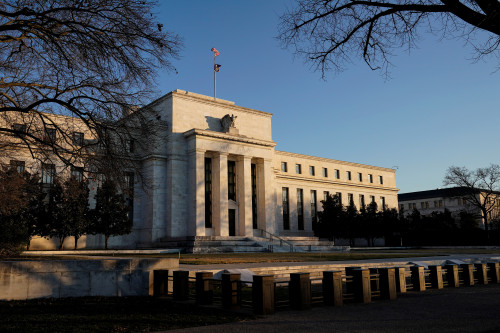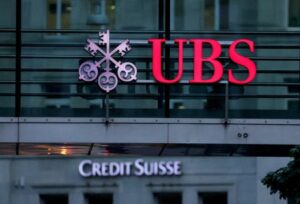By Michael S. Derby and Ann Saphir
(Reuters) -Top U.S. bank lending officers reported weaker demand from businesses and consumers for many types of credit during the first three months of the year, according to a Federal Reserve report released on Monday, reversing a short-lived surge in loan demand the previous quarter.
The number of banks reporting weaker demand for commercial and industrial loans outnumbered those reporting stronger demand by the biggest margin in a year for small firms, the central bank’s April Senior Loan Officer Survey detailing activity during the first quarter showed.
For large firms, demand for loans was the weakest since the third quarter of last year. Banks in the fourth quarter had reported a net increase in demand for C&I loans by firms of all sizes.
Banks also tightened lending standards for business loans, the report showed, with the net percentage of officials reporting stricter standards rising in the first quarter to the highest in a year and a half for large firms, and in a year for small firms.
On the lending to households front, lending standards were little changed, but the survey noted “weaker demand” for credit for residential real estate and credit cards and other types of consumer loans, while auto lending held essentially unchanged for the quarter.
Banks reporting weaker credit card loan demand outnumbered those reporting stronger demand by the biggest margin since the second quarter of 2020, the data showed.
In the report, bank lending officers tied tighter standards for companies to a more challenging economic environment. The survey cited “a less favorable or more uncertain” outlook coupled with “increased concerns about the effects of legislative changes, supervisory actions, or changes in accounting standards; the worsening of industry-specific problems; and a reduced tolerance for risk as important reasons for doing so.”
For households, tighter lending standards targeted credit card loans while auto lending standards held steady during the first quarter.
The Fed’s report covers a period of strong uncertainty and unsettled financial conditions brought about by the return of Donald Trump as president. The president’s hopes of restarting American manufacturing by way of massive tariffs on trading partners cast, and continue to cast, a substantial shadow over the economic outlook.
Economists have broadly agreed that the president’s trade agenda would likely re-accelerate inflation, depress growth and drive up unemployment. Meanwhile, a wide range of surveys of business sentiment have shown firms over the start of the year vexed by considerable uncertainty as they’ve tried to navigate the rapidly shifting nature of the president’s trade agenda.
At the same time, some reports have also shown a fraying in households’ assessment of their current and future financial situations.
With all that uncertainty, clarity over the outlook for the future of lending costs has also been up in the air. While Fed officials penciled in additional rate cuts at their March policy meeting, officials have for some time argued uncertainty over what lies ahead has left them in wait-and-see mode as they seek to gain clarity over the outlook.
More certainty entered the outlook Monday after the Trump administration announced a temporary trade deal with China that will bring tariffs down from extreme levels to simply high levels, sparking a large rally in asset prices.
The deal “is an improvement as far as trade between the two countries” is concerned, Fed Governor Adriana Kugler said in remarks in Ireland. The trade announcement, having potentially reduced risks to the outlook, caused traders to pare back bets of a Fed rate cut until September.
(Reporting by Michael S. Derby and Ann Saphir; Editing by Andrea Ricci)




